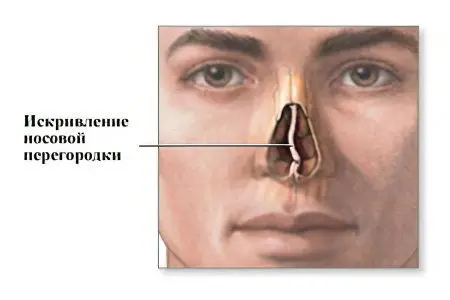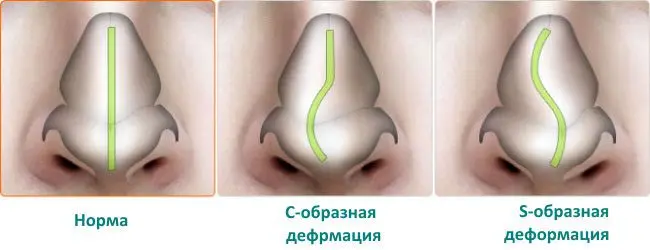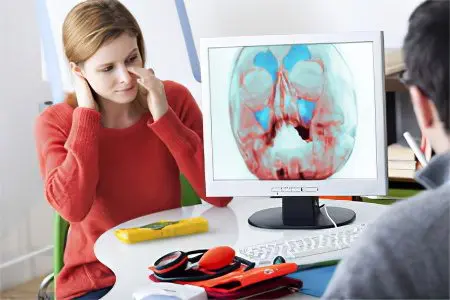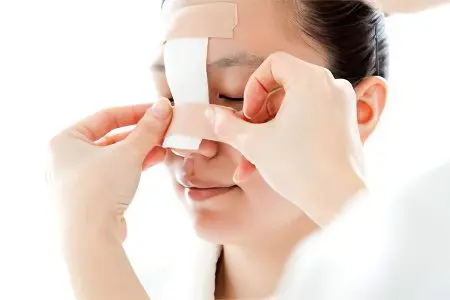Contents
A deviated septum occurs in many people. A perfectly even septum in the nose is a rarity. However, the curvature of this part of the nose can not always be regarded as a pathology. Only those people in whom a deviated nasal septum leads to health problems need treatment. The otolaryngologist deals with the diagnosis and selection of therapy.
Deviated septum

The nasal septum is represented by a plate that runs along the center of the nose. It divides the inhaled air into equal parts, ensuring that it is properly processed before entering the lower respiratory tract. He has time to warm up, cleanse and moisturize. If the septum is curved, then all these functions are violated.
A plate separating the nose with bone and cartilage tissue is presented. When its cartilage is displaced, an uneven distribution of air occurs. A similar situation leads to its spike deformation, as well as curvature in the form of a ridge. As an analysis of statistics shows, 95% of people have a curvature, but the degree of its severity varies.
Symptoms of a deviated septum

Symptoms that may indicate a deviated nasal septum:
Deterioration of nasal breathing. Depending on the degree of curvature, breathing may be impaired slightly or very severely. Sometimes the patient cannot breathe through the nose at all, inhaling through the mouth. Even if a person does not complain of breathing difficulties, this does not mean that his septum is even. It is likely that the deformation occurred at an early age, and the body has already managed to adapt to it. Breathing difficulties may not occur in patients with a large nasal cavity.
Chronic rhinitis. A person’s nose is stuffed up all the time. However, many people do not pay attention to this symptom, believing that the reason lies in the constant colds.
Allergy. When a person cannot breathe normally through his nose, this affects the state of his immunity. Gradually, he begins to weaken. The body is more often attacked by infectious agents and allergens. Therefore, in most patients with chronic nasal congestion, preasthma develops against the background of a deviated septum. This condition precedes bronchial asthma. The main signal of such a violation is an increase in rhinitis upon contact with allergens.
Headache. A curved section of the septum in the form of a ridge or spike contacts the nasal mucosa, irritating it. Nerve receptors are in constant tension, which leads to headaches.
Drying of the nasal mucosa, discomfort in the nose.
Bleeding from the nose. On the side where the bulge is located in the form of curvature, the mucous membrane becomes thin. Any pressure on it leads to the appearance of blood.
Apnea. Snoring is a consequence of a violation of the passage of air through the nasal passages.
Excessive fatigue, deterioration in working capacity, decrease in physical activity. These manifestations are explained by hypoxia of brain tissues.
Frequent infectious diseasesaffecting the respiratory organs. The patient coughs, sneezes, mucus constantly flows from his nose.
Chronic sore throat. A person complains of perspiration and dryness in the oropharynx.
Frequent inflammation of the middle ear with pain and hearing loss.
Violation of the shape of the nose. This symptom characterizes a traumatic curvature of the septum.
Causes of deviated septum

There are the following reasons leading to the curvature of the nasal septum:
Violation of the growth rate of various parts of the skull. This leads to the fact that the dimensions of the nasal cavity change, as a result of which the septum is deformed.
Received injuries. The stronger the bruise, the more the septum will be curved. If the bones grow together incorrectly, then a visible defect of the nose remains.
The presence of polyps and tumors growing from the nasal mucosa. The larger they are, the higher the probability of defect formation.
Hypertrophy of the nasal concha on one side. Its excess growth puts pressure on the septum, causing it to deform.
Types of curvature of the nasal septum
There are 2 classifications of the curvature of the nasal septum, depending on the causes that caused it and on the characteristics of the defect.
Classification of curvature according to Mladin
Rib-shaped curvature. It is small, concentrated in front of the partition, on one side. The person breathes freely through the nose.
Severe ridge curvature. This deformity leads to problems with nasal breathing.
Comb-shaped deviation with unilateral deformity, which is concentrated in the posterior part of the septum.
Deformation S-shaped. In this case, there are two ridge-shaped curvature, which are located in the right and left nasal sinuses.
Deviation according to the type of “Turkish saber”. The deformity is ridge-shaped, located in the back of the nose.
Deformations in the horizontal plane, combs are present in both nostrils.
Broken partition. There are many deformations, they are located in different planes.

Classification of curvature according to Lopatin
Thickened partition.
Septum with C-shaped curvature.
Partition – comb.
S-shaped partition.
The partition is a thorn.
Dislocation of the 4-coal cartilage and their combinations.
Consequences of a curvature of the nose

If a person has a deviated nasal septum, then this can lead to serious consequences:
Frequent colds.
Runny nose. Rhinitis can be allergic, atrophic, vasomotor, hypertrophic.
Inflammation of the sinuses: sinusitis, sinusitis.
Spasm of the larynx.
Otitis with a lesion of the middle part of the ear.
Bronchial asthma.
Chronic Fatigue Syndrome.
Violation of the menstrual cycle.
Diseases of the heart, eyes and other organs.
Fall of immunity.
Diagnostics of the curvature of the nasal septum

To understand whether a person with a deviated nasal septum needs any treatment, he needs to undergo an examination. In addition to an external examination of the septum, the otolaryngologist will perform rhinoscopy and other diagnostic techniques.
External examination by an otolaryngologist
The doctor examines the patient’s nose. If the curvature is the result of an injury, then the nose will have an irregular shape. Then the doctor evaluates the breathing of the right and left nasal passages. To do this, a person closes his nostrils one by one, and a thread or cotton wool should be placed next to the free nostril. The doctor evaluates the strength of inhalation and exhalation by the fluctuations of the thread.
Another test is to assess the patient’s olfactory function. To do this, cotton wool is moistened in an odorous substance and the person is asked to describe the smell that he feels. If the septum is significantly curved, the sense of smell will be reduced.
Rhinoscopy
Rhinoscopy is a procedure during which the doctor examines the patient’s nasal cavity. This is done using a special device. Such a diagnosis is carried out according to indications. Anterior and posterior rhinoscopy can be implemented. Anterior rhinoscopy is most often prescribed for patients with a deviated septum.
To conduct a study, the nostrils are expanded with a special device, after which a probe is inserted into it. With it, the doctor probes the mucous membrane lining the nasal cavity. This allows you to detect polyps, tumor neoplasms, areas of suppuration. If the doctor performs an examination through the oral cavity, then he can visualize hypertrophy of the posterior ends of the turbinates.
X-ray of the nose
Radiography does not allow to assess the degree of curvature of the patient’s nasal septum. The study is carried out mainly in order to obtain information about the condition of the paranasal sinuses.
Computed tomography and magnetic resonance imaging
CT and MRI are used when the most accurate information about the state of the nasal structures is required. With the help of images taken on a computed tomography, it is possible to visualize the ridges and spikes that are located in the posterior sections of the septum, as well as to diagnose concomitant pathologies of the nose, if any.
MRI is informative in terms of detecting tumors, polyps, cysts and other pathological changes in soft tissues.
Rhinoendoscopy
To perform a rhinoscopy, additional anesthesia will be required. Anesthesia is applied local. To conduct a study, a probe equipped with a microscopic video camera is inserted into the nasal cavity. With its help, the doctor examines the areas of interest to him.
Treatment of a deviated nasal septum

To correct the existing defect, you will need the help of a surgeon.
Surgical treatment – septoplasty
Depending on the extent of the intervention, the patient is given local or general anesthesia. The average duration of the procedure is 1-2 hours.
The doctor performs an incision and exfoliates the mucous membrane, after which the altered cartilage tissues are removed. The tissues are sutured, and gauze swabs are inserted into the nasal passages. They prevent bleeding and protect the wound from infection. The doctor puts a plaster on the nose. After the completion of the rehabilitation period, there are no bruises on the face, the edema completely disappears.
Endoscopic septoplasty
For endoscopic septoplasty, a fiber endoscope is used. Access to the affected area is performed through the nasal passages. No cuts need to be made. This avoids tissue injury, suturing is not required. The operation takes about an hour. After its completion, the doctor inserts cotton swabs into the nasal passages, and a retainer made of silicone is applied to the nose. A day later, they are removed, and the person is sent home. Full recovery occurs within 5-7 days.
Laser treatment
The main advantage of the procedure is its bloodless procedure. The tissue is cut using a laser. Under its influence, the blood vessels coagulate. To remove excess cartilage, they are heated. The doctor independently controls the temperature of exposure. After the procedure is completed, the nose is fixed in the correct position with a plaster cast. Gauze swabs are inserted into the nasal passages.
Benefits of laser treatment:
No cuts. The mucous membrane remains intact.
The bloodlessness of the procedure.
No risk of infection.
Absence of hematomas after the procedure.
The patient is not hospitalized. The procedure is carried out in an outpatient clinic, if it is equipped with the necessary equipment.
The tissues do not swell after the operation.
Recovery takes place as soon as possible.
However, it is not always possible to use a laser to correct the nasal septum. The procedure is not performed on patients with curved bone tissues, since only cartilage can be corrected with a laser. You won’t be able to save it either. The beam can only cut off a spike or comb.
Treatment without surgery
With the help of conservative therapy, it will only be possible to eliminate the inflammation that exists in the nasal cavity. Drug correction can be prescribed for patients with polyps, adenoids, allergic rhinitis. Thanks to the intake of medicines, the body’s resistance to various infections increases, nasal breathing is restored.
It will not be possible to straighten the nasal septum with the help of medicines. Nasal breathing may improve due to the removal of edema, or after the removal of polyps or adenoids. In some cases, osteopathy is indicated.









